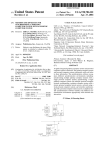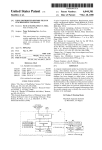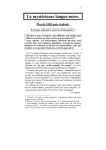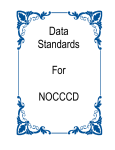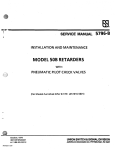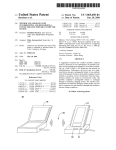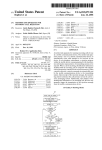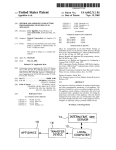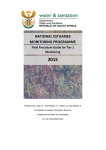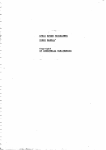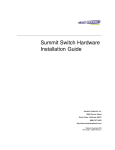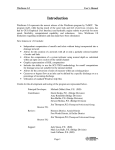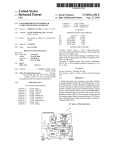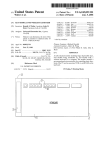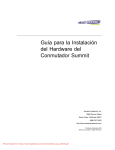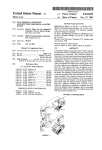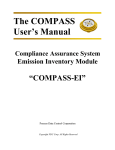Download L+_LJF.1L
Transcript
US006223187B1 (12) United States Patent (10) Patent N0.: (45) Date of Patent: Boothby et al. (54) DISTRIBUTED SYNCHRONIZATION OF Cobb et al., “Paradox 3.5 Handbook 3’“ Edition,” Bantam, pp. 803—816 (1991). FRx Extends Reporting PoWer of Platinum Series: (IBM DATABASES (75) Inventors: David J. Boothby; Robert C. Daley, both of Nashua, NH (US) Desktop SoftWare’s Line of Accounting Software), Doug Dayton, PC Week, v. 8, n. 5, p. 29(2) (Feb. 4, 1991). IntelliLink Brochure (1990). (73) Assignee: Puma Technology, Inc., San Jose, CA (Us) (*) Notice: “Logical Connectivity: Applications, Requirements, Archi tecture, and Research Agenda,” Stuart Madnick & Y. Rich Subject to any disclaimer, the term of this patent is extended or adjusted under 35 ard Wang, MIT, Systems Sciences, 1991 HaWaii Int’l, vol. 1, IEEE (Jun. 1991). USC 154(b) by 0 days. “Open NetWork Computing—Technical Overview,” Sun Technical Report, Microsystems, Inc., pp. 1—32 (1987). Organizer Link II Operation Manual, Sharp Electronics (21) Appl. No.: 09/449,644 (22) Filed: Nov. 30, 1999 Corporation, pp. 1—104. “The Big Picture (Accessing Information on Remote Data Management System,” UNIX RevieW, v. 7, n. 8, p. 38(7) Related US. Application Data (62) US 6,223,187 B1 Apr. 24, 2001 (Aug. 1989). Division of application No. 08/927,922, ?led on Sep. 11, 1997, now Pat. No. 6,044,381. (51) Int. Cl.7 .................................................... .. G06F 17/30 (52) US. Cl. .......................... .. 707/201; 707/10; 709/201; (List continued on next page.) Primary Examiner—Jean R. Homere (74) Attorney, Agent, or Firm—Fish & Richardson PC. 709/248 (58) Field of Search ........................... .. 707/3, 4, 10, 201, 707/202, 203; 709/203, 219, 217, 248, (57) ABSTRACT 201 A computer implemented method is provided for synchro (56) References Cited nizing a ?rst database located on a ?rst computer and a second database located on a second computer. At the ?rst computer, it is determined Whether a record of the ?rst database has been changed or added since a previous U.S. PATENT DOCUMENTS 4,432,057 4,807,182 4,819,156 2/1984 2/1989 4/1989 Daniell et a1. ..................... .. 395/608 Queen ............. .. 395/144 DeLorme et al. ............ .. 395/182.13 synchronization, using a ?rst history ?le located on the ?rst computer comprising records representative of records of the ?rst database at the completion of the previous synchro (List continued on next page.) nization. If the record of the ?rst database has not been OTHER PUBLICATIONS Al?eri, “The Best of WordPerfect Version 5.0,” Hayden changed or added since the previous synchronization, the ?rst computer sends the second computer information Which Books, pp. 153—165, 429—435 (1988). “Automatically Synchronized Objects,” Research Disclo the second computer uses to identify the record of the ?rst database to be unchanged. sure #29261, p. 614 (Aug. 1988). Chapura, Inc., 3 Compare, http://WWW.champura.com/ 3compare.html (1997), pp. 1—2. Chapura, Inc., PilotMirror Features Page, http://WW W.chapura.com/features.html (1997), pp. 1—4. 4 Claims, 8 Drawing Sheets Micro?che Appendix Included (2 Micro?che, 153 Pages) DATABASE CHARACTERISTICS AND DEFAULT VALUES F USER INPUT 30' __L+_LJF.1L CONTROL MODULE 2 ’ . |__ _ _~——- l ' I ILUNLOADER LQ ——— ——l 24 ' SYNCHRONIZER B_READER 11 —» _III REMOTE | SEGMENT 1_5 ' BiTRANSLATOR g I A :—WORKSPACE_: F BOSE-l L6 ' HISTORY '- 26 - TRANSLATOR REMOTE DATABASE I 32 E| zsJjTEMOTET 1' REMOTE _‘ — l -- - I HISTORY| LWORKSPACEJ _ I |_ _ EL J JLEQ I REMOTE COMPUTER Q US 6,223,187 B1 Page 2 US. PATENT DOCUMENTS 4,827,423 4,866,611 4,875,159 4,956,809 5/1989 5,600,834 5,613,113 Beasley er a1- -------------------- -- 364/468 9/1989 Cree et a1. 10/1989 Cary et al. .. 395/600 395/619 9/1990 George et a1 5,615,364 2/1997 Howard .............................. .. 395/617 3/1997 Goldring ............................ .. 395/618 3/1997 Marks ................................ .. 395/618 576197689 576307081 4/1997 Kelly 5/1997 Rybicki et aL _ _ 395/617 _ 395/948 . 395/617 395/601 5,666,530 9/1997 Clark et al. .. 4,980,844 12/1990 Dernl'anenkO 919- 364/550 5,666,553 9/1997 CroZier ...... .. .395/803 5,065,360 11/1991 Kelly ............... .. 395/800 395/600 576827524 5,684,984 10/1997 Freund et a1_ 11/1997 Jones et al. .. _ 395/6O5 . 395/610 5,136,707 8/1992 Block er a1 5,142,619 8/1992 Webster, III .. 395/161 576847990 11/1997 Boothby _ 395/619 5,155,850 10/1992 Janis et a1. 5,170,480 * 12/1992 Mohan et a1. . .. 395/600 .. 711/115 577017423 577087812 12/1997 CrOZier __ 1/1998 Van Dyke et a _ 395/335 _ 395/712 5,187,787 5,210,868 .. 395/600 -- 395/615 577087840 5,710,922 1/1998 Kikinis et a1 1/1998 Alley et al. .. _ 395/8OO 395/617 5,228,116 2/1993 Skeen et a1. 5/1993 Shimada er a17/1993 Harris et a1. 395/54 577277202 3/1998 Kucala _ 395/610 5,237,678 8/1993 .. 395/600 577297735 3/1998 Meyering _ _ 395/61O . 364/550 395/161 577457712 5,758,150 4/1998 Tuprin et aL 5/1998 Bell et al. 395/333 . 395/610 ' 7O7/2O1 Kuechler et a1. .. 5,251,151 5,251,291 10/1993 Demjaneko et a1. . 10/1993 Malcolm 5,261,045 11/1993 Scully et a1. . 395/161 577587355 * 5/1998 Buchanan 5,261,094 11/1993 Everson er a1- -- 395/617 5,778,388 7/1998 Kawamura et al. 5,272,628 12/1993 Koss .......... .. 364/419.19 577907789 8/1998 5,278,978 1/1994 DCIIICIS et a1. . 395/600 578097494 * 9/1998 Nguyen _ 5,278,982 5,283,887 1/1994 Daniels er a12/1994 Zachery -- 395/600 395/500 5,293,627 5,301,313 3/1994 Kato et a1- -4/1994 Terada er a1- -- -- 395/550 -- 395/600 Suarez _______ __ 5,832,489 * 11/1998 Kucala 5,845,293 12/1998 Veghte etal. 5,870,759 5,870,765 2/1999 Bauer et al. . 2/1999 Bauer et al. . 707/203 395/2OQ32 707/1 707/10 . 707/202 707/201 707/203 5315709 5/1994 Alston, Jr~ 9t a1~ - 395/606 5,884,323 * 3/1999 Hawkins et al. 707/201 5,327,555 7/1994 Anderson ........ .. .. 395/617 578847324 3/1999 Cheng et at 7O7/2O1 5,333,252 7/1994 Brewer, III et a1~ - 395/767 5,884,325 3/1999 Bauer et al. . 707/201 5,333,265 7/1994 Orimo et a1. .. 395/200 578977640 4/1999 Veghte et a1_ 7O7/2O2 5,333,316 7/1994 Champagne er a1 - 395/600 5,926,824 7/1999 Hashimoto et al. 5,339,392 8/1994 Risberg et a1. 395/161 579437676 8/1999 Boothby 5,339,434 5,355,476 8/1994 Rusis ----- -10/1994 Fukumura 5,375,234 5,392,390 12/1994 2/1995 395/700 ~395/600 Davidson er a1- ----------------- -- 395/600 CroZier ............................... .. 395/335 .. 5,978,813 11/1999 Foltz etal. 6,018,303 * 1/2000 Sadeh ..... .. 6,125,369 * . 707/520 _ 7O7/2O1 .707/201 341/51 9/2000 Wu etal. ........................... .. 707/201 5,396,612 3/1995 Huh et a1. 5,434,994 7/1995 OTHER PUBLICATIONS 5,444,851 8/1995 Woest .............................. .. 395/200.1 User Manual for Connectivity Pack for the HP QSLX, 5,475,833 12/1995 Dauerer~et Pascucci Ct a1. 8.1. .................... .. .. 395/617 User Hewlett Manual Packard for PC_Link Companyfor the B'OSS' and the PC_Link Shaheen et a1. ................... .. 395/617 5,511,188 4/1996 Pascuccl et a1. ................... .. 395/600 575197606 5/1996 FridNielsen et a1‘ N 395028 for the B.O.S.S., Travellng Software, Inc. (1989), pp. 1—82. 5,530,939 * 5,560,005 6/1996 Mans?eld, Jr. et al. ........... .. 707/201 9/1996 Hoover et al. ..................... .. 395/600 Zahn 9t 41-, Network Computing Architecture, pp- 1—11; 19—31; 87—115; 117—133; 187—199; 201—209 (1990). 5,568,402 10/1996 Gray et a1. .. 5,583,793 12/1996 Gray et a1. ..................... .. 364/514 C . . 364/514 C * cited by examiner U.S. Patent Apr. 24, 2001 Sheet 3 of 8 \>0<1m <m s/ mGE PM XQwmOZP_Xm US 6,223,187 B1 502m 8m1%.amzwb xmaz wo<mum502m vmaz 3I1085 xwaz U.S. Patent Apr. 24, 2001 Sheet 5 of 8 US 6,223,187 B1 501. 502. 503. S04. 505. 506. 507. 508. INITIALIZE an empty remote workspace 11-‘ there is a remote history ?le matching the host history ?le name IF the remote history ?le time stamp matches the history ?le time stamp LOAD the remote history ?le into the remote workspace ELSE 509. 5l0. 51 l. 512. 513. 514. 515. 516. 517. 518. 5l9. 520. ELSE REMOVE the non-matching history ?le Proeecd with the empty workspace, all records passed to host ENDIF Proceed with the empty workspace, all records passed to host ENDIF FOR each record in the remote database Translate and load data ?eld values and unique ID into remote workspace Compute a hash value to represent all translated data values IF the unique ID matches the unique [D of an existing remote history ?le entry, IF the hash value is the same Skip this entry, the host will recreate this record from history ELSE Send Unique ID, ?eld values and "Changed" reeord flag to the host Create M workspace entry with same unique ID and new hash value This new entry is marked as “unacknowledged" 521. 522. ENDIF ELSE 523. 524. 525. 526. 527. 528. 529. 530. 531. 532. 533. 534. 535. 536. 537. 538. 539. 540. 541. 542. 543. Send Unique ID, ?eld values and "Added" record ?ag to the host Create new workspace entry with new unique ED and new hash value This new entry is marked as “unacknowledged' ENDIF NEXT FOR each unique ID in the remote history ?le not matched in the above loop, Send Unique ID and uDeleted" flag to the host NEXT WAIT for host to synchronize the data and for user to con?rm results IF user has aborted the synchronization The remote workspace is discarded. The original remote history ?le remains unmodi?ed. The process is terminated. ENDIF FOR each record “action" or “acknowledgment" received from the host, IF this is an acknowledgment of a record Added or Updated in the remote database. Mark any corresponding. newly created workspace item as “acknowledged" Remove any prior workspace item with the same unique ID ELSE IF this is a new action to Add, Update, or Delete a remote database record UPDATE remote workspace to re?ect the appropriate change Mark any corresponding, newly created workspace item as “acknowledged“ 544. 545. 546. 547. 548. 549. 550. 551. 552. Remove any prior workspace item with the same unique ID IF this is an Add SEND the new unique ID back to the host to include in history ?lc ENDIF ENDIF NEXT REMOVE any newly create, but “unacknowledged" entries from the workspace UPDATE the remote history ?le from the remote workspace FIG. 5 U.S. Patent Apr. 24, 2001 Sheet 7 of 8 US 6,223,187 B1 INITIALIZE an empry remote Workspace IF there IS a remote history ?le matching the host history ?le name IF the remote history ?le time stamp matches the history ?le time stamp LOAD the remote history ?le into the remote workspace ‘01. ‘O2. ‘O3. ‘O4. ‘O5. ‘O6. ."07. ELSE REMOVE the non-matching history ?le Proceed with the empty workspace. all records passed to host ENDIF 708. 709. 710. ELSE Proceed with the empty workspace. all records passed to host ENDIF FOR each record in the remote database, Translate and load data ?eld values into the remote Workspace 711. ."lZ. Tl}. 714. 715. 7l6. 7l7. Compute a hash value to represent all translated data values IF the hash value matches the hash value of one or more remote history ?le enrries, Send hash value. remote workspace index, and “Unchanged" record ?ag to the host ELSE Create new workspace entry with new new hash value and remote workspace index This new enrry is marked as “unacknowledged“ ‘'18. 719. 720. Send hash value. remote workspace index, ?eld values and "Added" record ?ag to the host 721. 722. 723. 724. 725. 726. 727. 728. 729. 730. "st. 722. ‘33. 734. 735. 736. 737. 738 ENDIF NEXT REMOVE any “prior' workspace entries not matched by hash value above WAIT for host to synchronize the data and for user to con?rm results IF user has aborted the synchronization The remote workspace is discarded. The original remote history ?le remains unmodi?ed. The process 15 terminated. ENDIF FOR each record “action“ or “acknowledgment“ received from the host, IF this is an acknowledgment of a record sent to the host (above) as “added', Mark any corresponding, newly created workspace item as “acknowledged" ELSE IF this is a new action to Add. Update. or Delete a remote database record UPDATE remote workspace to re?ect the appropriate change Mark the updated record as “aeknowledged" ENDIF NEXT REMOVE any newly create. but “unacknowledged" entries from the workspace ‘UPDATE the remote history ?le from the remote workspace FIG. 7 US 6,223,187 B1 1 2 DISTRIBUTED SYNCHRONIZATION OF DATABASES one With entries on another. The US. patent and copending patent application of the assignee hereof, Puma Technology, Inc. of St. Jose, Calif. (US. Pat. No. 5,392,390 (hereinafter, CROSS REFERENCE TO RELATED APPLICATION “the ’390 patent”); US. application, Ser. No. 08/371,194, ?led on Jan. 11, 1995, incorporated by reference herein) shoW tWo methods for synchroniZing incompatible data bases and solving some of the problems arising from incom patibility of databases. Synchronization of tWo incompatible databases often This application is a divisional of US. application Ser. No. 08/927,922, ?led Sep. 11, 1997, now US. Pat. No. 6,044,381. REFERENCE TO MICROFICHE APPENDIX 10 matched up prior to synchroniZation. This may require An appendix (appearing noW in paper format to be transferring records in one database from one computer to another. HoWever, if the data transfer link betWeen the tWo computers is sloW, as for example is the case With current replaced later in micro?che format) forms part of this application. The appendix, Which includes a source code listing relating to an embodiment of the invention, includes requires comparison of their records so that they can be 15 153 frames on 2 micro?che. infrared ports, telephone modem, or small handheld computers, such a transfer increases the required time for This patent document (including the micro?che appendix) contains material that is subject to copyright protection. The synchroniZation by many folds. copyright oWner has no objection to the facsimile reproduc tion by anyone of the patent document as it appears in the Patent and Trademark Of?ce ?le or records, but otherWise SUMMARY 20 reserves all copyright rights Whatsoever. a ?rst computer and a second database located on a second computer. At the ?rst computer, it is determined Whether a record of the ?rst database has been changed or added since BACKGROUND This invention relates to synchroniZing databases. 25 Databases are collections of data entries Which are organiZed, stored, and manipulated in a manner speci?ed by applications knoWn as database managers (hereinafter also referred to as “Applications”; the term “database” Will also refer to the combination of a database manager and a In one aspect, the invention features a computer imple mented method for synchroniZing a ?rst database located on 30 a previous synchroniZation, using a ?rst history ?le located on the ?rst computer comprising records representative of records of the ?rst database at the completion of the previous synchroniZation. If the record of the ?rst database has not been changed or added since the previous synchroniZation, the ?rst computer sends the second computer information Which the second computer uses to identify the record of the database proper). The manner in Which database entries are ?rst database to be unchanged. organiZed in a database is knoWn as its data structure. The embodiments of this aspect of the invention may There are generally tWo types of database managers. First are general purpose database managers in Which the user 35 include one or more of the folloWing features. A second history ?le may be located on the second determines (usually at the outset, but subject to future revisions) What the data structure is. These Applications often have their oWn programming language and provide great ?exibility to the user. Second are special purpose database managers that are speci?cally designed to create and manage a database having a preset data structure. Examples of these special purpose database managers are 40 various scheduling, diary, and contact manager Applications for desktop and handheld computers. Database managers organiZe the information in a database into records, With 45 each record made up of ?elds. Fields and records of a database may have many different characteristics depending on the database manager’s purpose and utility. Databases can be said to be incompatible With one another When the data structure of one is not the same as the data 50 structure of another, even though some of the content of the records is substantially the same. For example, one database may store names and addresses in the folloWing ?elds: the information stored in relation to the one of the repre sentative records in the second history ?les. FIRSTiNAME, LASTiNAME, and ADDRESS. Another database may, hoWever, store the same information With the The information sent to the second computer can include 55 folloWing structure: NAME, STREETiNO, STREETi information identifying records other than the unchanged record. It can also include information identifying the changed record. It can also include information identifying NAME, CITYiSTATE, and ZIP. Although the content of the records is intended to contain the same kind of the deleted records or added records. The information can also include a code based on at least a portion of the content information, the organiZation of that information is com pletely different. computer. The second history ?le contains records repre sentative of records of the ?rst database at the completion of the previous synchroniZation, Where one of the representa tive records represents the record of the ?rst database determined to be unchanged. Then, at the second computer, a synchroniZation of the second and ?rst databases is per formed using the one of the representative records. The information sent from the ?rst computer to the second computer can be used to locate the one of the representative records in the second history ?le. The second history ?le can store information in relation to the representative records and the one of the representative records in the second history ?le can be identi?ed from that stored information. Additionally, the information sent from the ?rst computer to the second computer can include information that matches 60 of the record of the ?rst database. The code may be a hash Often users of incompatible databases Want to be able to number. The information may be a code uniquely identifying synchroniZe them With one another. For example, in the context of scheduling and contact manager Applications, a person might use one Application on the desktop computer the record of the ?rst database. Such a code may be one assigned by the ?rst database to the records. In another aspect, the invention features a computer at Work While another on his handheld computer or his 65 implemented method of identifying a record of a database. laptop computer While aWay from Work. It is desirable for many of these users to be able to synchroniZe the entries on A record of the database is read. A code is assigned to the record of the database, the code being based on at least a US 6,223,187 B1 4 3 portion of the content of the record of the ?rst database. The code is then to identify the record at a later time. The embodiments of this aspect of the invention may FIG. 5 is pseudocode for a remote segment of a synchro niZation program When loading records from and unloading records to the remote database, When the database assigns include one or more of the following features. The code may be a hash number computed based on at unique IDs. least a portion of the content of a record of the ?rst database. The database is stored on a ?rst computer and the code is transmitted. to a second computer to identify the record to an Zation program When loading records from and unloading records to the remote database, When the database assigns application. FIG. 6 is pseudocode for a host segment of a synchroni unique IDs. FIG. 7 is pseudocode for a remote segment of a synchro 10 Advantages of the invention may include one or more of niZation program When loading records from and unloading the following advantages. When synchroniZation is performed using the invention, records to the remote database, When the database does not a data transfer link, specially a sloW data transfer link, is Zation program When loading records from and unloading records to the remote database, When the database assigns used efficiently, since unchanged records that are typically assign unique IDs. FIG. 8 is pseudocode for a host segment of a synchroni 15 the majority of the records in a database are not transferred unique Ids. betWeen the tWo computers. Hence, When synchroniZing tWo databases on tWo different computers, the time needed to DESCRIPTION synchroniZe the tWo databases is decreased Also, When transmitting data from one computer to another, using a content based code, that requires less bandWidth for being transmitted and nonetheless identi?es a record, results in a sloW data transfer links being used more Brie?y, referring to FIGS. 1 and 2, a synchroniZation program, according to the embodiments described here, has a host segment 28 and a remote segment 26 Which run on a host computer 20 and a remote computer 22, respectively. The tWo computer are connected together via a data transfer ef?ciently. The invention may be implemented in hardWare or softWare, or a combination of both. Preferably, the technique 25 serial infrared links, serial cables, modems and telephone is implemented in computer programs executing on pro lines, or other such data transfer links. A host database 13 and a remote database 14, eg scheduling databases, are stored on remote computer 22 and host computer 20, respec grammable computers that each include a processor, a storage medium readable by the processor (including vola tile and non-volatile memory and/or storage elements), at tively. least one input device, and at least one output device. Program code is applied to data entered using the input device to perform the functions described above and to generate output information. The output information is applied to one or more output devices. 35 Each program is preferably implemented in a high level procedural or object oriented programming language to communicate With a computer system. HoWever, the pro grams can be implemented in assembly or machine language, if desired. In any case, the language may be a Generally, in some instances, both computers on Which the tWo databases run are capable of running programs other than a database, as in the case of, for eXample, general purpose computers such as desktop and notebook computers, or handheld computers having suf?cient memory and processing poWer. In such a case, the synchroniZation program may be distributed betWeen the tWo computers so as to, for example, increase the efficiency of using of a sloW data transfer link betWeen the tWo machines. Brie?y, at remote computer 22, remote segment 26 of the synchroniZation program loads records of remote database 13. Remote segment 26 then determines Which records of the remote database have been changed/added, deleted or compiled or interpreted language. Each such computer program is preferably stored on a storage medium or device (e.g., ROM or magnetic diskette) that is readable by a general or special purpose program link 24 enabling them to transfer data betWeen them. Data transfer link 24 may be a sloW data transfer link such as a mable computer for con?guring and operating the computer left unchanged since a previous synchroniZation. If the remote database assigns unique identi?cation codes (i.e. When the storage medium or device is read by the computer to perform the procedures described in this document. The unique ID) to its records, remote segment 26 can further differentiate betWeen records than have been added and system may also be considered to be implemented as a those than have been changed since the previous synchro computer-readable storage medium, con?gured With a com puter program, Where the storage medium so con?gured Which stores data representing or re?ecting the records of 45 niZation. Remote segment 26 uses a remote history ?le 30 causes a computer to operate in a speci?c and prede?ned the database at the completion of the previous synchroniZa manner. tion. This data may be a copy of remote database 13. It may also be hash numbers for each of the records of the remote Other features and advantages of the invention Will become apparent from the folloWing description of various embodiments, including the draWings, and from the claims. 55 database. If the remote database assigns unique IDs, the remote history ?le may contain those unique IDs together With the hash numbers of the records corresponding to the stored unique IDs. BRIEF DESCRIPTION OF THE DRAWING FIG. 1 shoWs tWo computers connected via data transfer link. FIG. 2 is a schematic draWing of the various modules constituting an embodiment. FIG. 3 is a representation of the host Workspace data array. FIG. 4 is pseudocode for the Translation Engine Control Module. Remote segment 26 sends those records of the remote database that have been changed or added to the host segment or the host computer. HoWever, the remote segment does not send the unchanged or deleted records to the host computer. Instead, the remote segment sends a ?ag indicat ing the status of the record (e.g. unchanged or changed) and 65 some data or information that uniquely identi?es the record to the host segment. This data or information may be a hash number of all or selected ?elds in the record at the comple US 6,223,187 B1 5 6 tion of the last synchronization. It may also be the unique ID assigned to the record by the remote database, if the database pseudocode to generally describe distributed synchroniza tion according to the invention. Control Module 2 ?rst initializes itself and speci?es the current user options to assigns one to its records. Host segment 28 uses the received information or data that uniquely identi?es the unchanged record to access a various modules (Step 401). In step 402, control module 2 information or data. This record contains a copy of the data instructs the Synchronizer to load host history ?le 19. Synchronizer 15 in response creates host Workspace 16 data array and loads host history ?le 19 into host Workspace 16. of the remote database record that the remote segment found to have been unchanged. Host segment 19 then uses this synchronization and contains records. representative of the record in host history ?le 19 that corresponds to the received record to synchronize the databases by comparing it to the records of host database 14. After synchronization, the remote and host history ?les and the databases are updated. Since the unchanged records Which typically constitute most Host history ?le 19 is a ?le that Was saved at the end of last 10 of the records of a database are not transferred to the host computer, a data transfer link, specially a sloW data transfer link, is used With increased ef?ciency. 15 We Will describe tWo embodiments of a distributed syn chronization program. We Will ?rst describe in general terms the overall structure of the distributed synchronization pro records of the tWo databases at the end of the previous synchronization. Typically, the host history ?le contains a copy of the results of the previous synchronization of the synchronized records of the tWo databases. It should be noted that the content of the records of the history ?le may be limited only to those ?elds that are synchronized and the data may be translated and stored in a format different than that of the remote database or the host database. This data can be used to reconstruct the content of the records of the remote database as they Were at the end of the previous gram in reference to FIGS. 2 and 3 Which is common to both synchronization. The host history ?le is generally used to embodiments. We Will then describe then the ?rst and second embodiments performing a distributed synchroniza tion in reference to FIGS. 4—8. FIG. 2 shoWs the relationship betWeen the various mod ules of an embodiment of a distributed synchronization program. Translation Engine 1 comprises a Control Module determine changes to the databases since a previous syn chronization and also to recreate records not sent from the remote segment, as Will be described in detail beloW. If no 25 history ?le from a previous synchronization eXists or the user chooses to synchronize Without using the history ?le, in step 402 the synchronizer does not load a history ?le. In that case, all the records from both databases Will be loaded into the host Workspace. We Will describe the rest of the opera tion of the control module as if a history ?le eXists and Will be used. 2 that is responsible for controlling the synchronizing pro cess by instructing various modules to perform speci?c tasks on the records of the tWo databases being synchronized. The Control Module 2 also provides data that affects the speci?c operation of the various components of the synchronization Once the History File is loaded into the host Workspace, program, such as the name of the databases being synchro nized and user preferences. FIG. 4 is the pseudocode of the Control Module 2 instructs host translator 13 to load the host database records (step 403). Host Reader module 11 of the steps taken by this module. The Synchronizer 15 has pri mary responsibility for carrying out the core synchronizing 35 functions. It is a table-driven code Which is capable of synchronizing various types of databases Whose character istics are provided by control module 2. The Synchronizer host Translator reads the host database records and sends them to the Synchronizer for Writing into the host Work space. Control Module 2 then instructs remote segment to send the records of the remote database (step 404). Remote creates and uses a host Workspace 16 (shoWn in detail in segment 26 reads the remote database records and sends FIG. 3), Which is a temporary data array used during the them to Synchronizer 15 for Writing into the host Workspace. The actions taken by the synchronizer and the remote segment in response to step 404 Will be described in detail in reference to FIGS. 5, 6, 7, and 8, beloW. Records in the host Workspace are stored according to synchronization process. Ahost translator 9 includes tWo modules: a reader module 10 Which reads the data from the host database 14 and an unloader module 10 Which analyzes and unloads records from the host Workspace into the host database 14. Remote segment 26 also has similar modules for reading and unload ing data from the remote database. The remote segment is 45 the Synchronizer maps that record using the appropriate designed speci?cally for interacting With remote database 13. The design of the remote segment is speci?cally based record map (i.e. either a remote database to host database record map or a host database to remote database record map) before Writing the record into the neXt available spot in the host Workspace. Mapping may be performed by other on the record and ?eld structure of the remote database and remote database’s Application Program Interface (API) requirements and limitations and other characteristics of the remote database. Similarly host translator 9 is designed speci?cally for the host database. The remote segment and host translator are not able to interact With any other 55 databases or Applications. They are only aWare of the characteristics of the databases for Which they have been designed. In an alternate embodiment, the host translator and Module 2 of the Translation Engine 1. We Will use this modules, eg the remote segment. The records may also be “translated”, i.e. cast into a format Which synchronizer can use (a “translation” method is described in the ’390 patent). For example, a date stored as “Apr. 1, 1997” may be translated into a format preferred by the synchronizer, e.g. Apr. 1, 1997 Control module 2 then instructs the Synchronizer to the remote segment can be designed as a table-driven code, Where a general Translator is able to interact With a variety of databases based on the parameters supplied by, for eXample, the Control Module 2. It should be noted that the remote segment and host translator may be designed in various Ways and still perform the tasks set out in this embodiment. FIG. 4 is the pseudocode for the operation of Control either the host database or the remote database data struc tures. Therefore, as synchronizer 15 receives each record, perform a Con?ict Analysis and Resolution (“CAAR”) procedure on the records in the host Workspace (step 405), Which procedure is described in detail in the folloWing applications of the assignee hereof, Puma Technology, Inc. of St. Jose, Calif. incorporated by reference in their entirety including any appendices: “Synchronization of Recurring 65 Records in Incompatible Databases”, Ser. No. 08/752,490, ?led on Nov. 13, 1996 (hereinafter, “’490 application”); “Synchronization of Databases With Record Sanitizing and US 6,223,187 B1 7 8 Intelligent Comparison,” Ser. No. 08/749,926, ?led Nov. 13, unique IDs) to each of its records as they are created. In the case of the second embodiment, the remote database does not assign unique IDs to its records. FIG. 5 is the 1996 (hereinafter, “’926 application”); “Synchronization of Databases With Date Range,” Ser. No. 08/748,645, ?led Nov. 13, 1996 (hereinafter, “’645 application”). Generally, pseudocode for the steps taken by the remote segment While FIG. 6 is the pseudocode for the steps taken by the Syn synchronization is a process of analyzing records from the remote database and host database against the records of the history ?le to determine the changes, additions, and dele tions in each of the tWo databases since the previous synchronization and What additions, deletions, or updates need be made to the databases to synchronize the records of the databases. Brie?y, during CAAR, the synchronization engine (i.e. the Synchronizer) compares the records in the host Workspace and determines What synchronizing actions should be taken. The synchronization engine processes the records, including comparing them to one another, in order 10 have been changed/added, deleted or left unchanged since a previous synchronization. The remote segment uses a his 15 to form them into groups of related records. Each of these associates With that record, the speci?c “action” (eg add, 20 ’926 & ’645 applications. Therefore, for eXample, this method of distributed synchronization may also be imple 25 over the data transfer link, only the content of those records 30 35 deletions. HoWever, prior to doing so, the user is asked to con?rm proceeding With unloading (steps 108—109). Up to process. After all necessary information has been transferred to the 40 If the user chooses to proceed With synchronization and to unload, the records are then unloaded in order into the host database, the remote database and the History File. The host segment, the Synchronizer synchronizes the databases. FolloWing synchronization, the host segment transfers infor mation necessary to update the remote database and the remote history ?le to the remote segment. The remote segment then updates its history ?le and the remote data 45 Synchronizer 15 creates a host history File and unloads the records into it. Control Module 2 ?rst instructs the host translator to unload the records from host Workspace into the host database. FolloWing unloading of the host records., segment. Only some data or identi?cation code that uniquely identi?es the record to the Synchronizer need be transferred for such a record. Since the majority of records are typically unchanged records, not transferring them over the sloW data transfer link improves the ef?ciency of the synchronization this point, neither the databases nor the History File have been modi?ed. The user may obtain through the Control Synchronizer in conjunction With the host translator and the remote segment perform the unloading for the databases. that have been changed or neWly added. As for unchanged records, the history ?le contains all necessary information to recreate or synchronize those records, if needed. Therefore, it is not necessary to transfer those records to the host Once Synchronizer 15 ?nishes performing CAAR on the records, the records may be unloaded or Written into their Module’s Graphical User Interface (GUI) various informa tion regarding What Will transpire upon unloading. mented With any synchronization program that is able to synchronize such databases. Generally, the remote segment sends the host segment, response to the output of CAAR as the output relates to the remote database. respective databases, including any additions, updates, or added, deleted, or left unchanged. Fast synchronization databases and an eXample of a method of synchronizing them With other databases is described in detail in the ’490, update or delete) that must be taken With respect to that record in that record’s database. During “CAAR”, the user may select not to synchronize a particular record With the other database. We Will describe beloW in detail the steps performed by the synchronizer and the remote segment in tory ?le located on the remote computer (“remote history ?le”) to determine Which records may have been changed/ added, deleted or left unchanged since a previous synchro nization. The remote segment essentially can translate out puts of any database into outputs of a fast synchronization database Which is a type of database that generally supplies information as to Which of its records have been changed, groups may comprise at most one recurring or a group of related nonrecurring records from each of the databases and history ?le. After forming these groups from all records of the tWo databases, the Synchronizer determines What syn chronization action should be taken. To do this, the Syn chronizer compares them, determines their differences, and decides What synchronization action is appropriate or asks the user What action should be taken. The synchronizer then chronizer in the case of the second embodiment. Similarly, FIG. 7 is the pseudocode for the steps taken by the remote segment While FIG. 8 is the pseudocode for the steps taken by the Synchronizer in the case of the ?rst embodiment. Brie?y, the remote segment determines Which records base. Since both the host and remote segments rely heavily on history ?les to enable distributed synchronization, it is important that the host and remote segments use history ?les 50 Control Module 2 instructs the synchronizer and the remote segment to unload the remote records from the host Work space (step 409). We Will describe in detail beloW, in reference to FIGS. 5—8, the speci?c actions taken by Syn that correspond to one another, i.e. both contain records corresponding to a previous synchronization of the same tWo databases. In the described embodiment, the remote and host history ?les are named using a common naming convention. The name of a ?le is made up of siX components: 1) Name or ID of the host computer, Which may be an chronizer 15 and remote segment 26 in order to unload data 55 assigned name such as an assigned GUID in the case of from the host Workspace into the remote database and the operating systems by Microsoft Corporation of update remote history ?le 28. Control Module 2 neXt instructs the Synchronizer to create a neW History File (step Redmond, Washington, or UUID in the case of oper ating systems by Open SoftWare Foundation; 112). At this point Synchronization is complete. Referring to FIGS. 5—8, We Will noW describe the actions taken by the remote segment in coordination With the Synchronizer in response to the instructions from control module 2 in step 404 to load records of the remote database and in step 409 to unload the records of the remote database from the host Workspace. Speci?cally, We Will describe tWo embodiments. In the case of the ?rst embodiment, the remote database assigns unique identi?cation codes (i.e. 60 2) Name or ID of the host database application, eg trademark designations “Lotus Organizer” or “Microsoft Schedule+”; 3) Name or ID of the host database ?le as stored on the 65 long term storage (e.g. hard disk drive) of the host computer, eg “My Calendar”; 4) Name or ID of the remote computer; 5) Name or ID of the remote database application; and US 6,223,187 B1 9 10 6) Name or ID of the remote database. Therefore, the remote segment and the host segment ensure that the host history ?le have the same name. Moreover, each of the history ?les have the date and time stamp of the Hashing may be described as converting any data, such as a string of characters, into a more compacted format, such as a number, meant to represent that string of characters. It may be considered to be a content-based encoding technique. The previous synchroniZation. The remote segment and hashed values may be used as a surrogate for a hashed string of characters, for example, to compare strings. An example synchroniZer use this to ensure that the history ?les from the same previous synchronization of the tWo of a hashing algorithm is to calculate the folloWing sum for every characters in a character string: databases are used. Having described in general terms the actions taken by the remote segment in coordination With the SynchroniZer in response to the instructions from control module 2 in steps 404 and 409 (FIG. 4), We Will noW describe in detail a ?rst embodiment of their operation for the case Where the remote database assigns unique IDs to its records. We Will do so in reference to FIGS. 5 and 6. 10 sum=character+(31 *sum), Where character is the number stored in the memory to represent that character (eg an Ascii value). (It should be 15 FIG. 5 is the pseudocode for steps taken by the remote segment in response to the instruction by control module in noted that there are many Ways of hashing data.) At the end of the computation, sum contains the hash number for that string of characters. In the described embodiments, the hash number is a 32 bit number and therefore can have a value step 404 to load the remote database records into the host betWeen 232 different values. Because the expected number of records is much less than this number, the probability of Workspace (FIG. 4). The remote segment ?rst initialiZes (i.e. tWo different records having the same hash value is small. creates) a remote Workspace in the remote computer (step Therefore, hash numbers can be used to perform compari 501). The remote segment then compares the name of the host history ?le With the name of any remote history ?le in nary check before comparing the data, With relatively loW sons instead of comparing the non-hashed data or a prelimi the remote computer. If the remote segment ?nds a remote history ?le that matches the host history ?le (i.e. a remote history ?le that matches the host history ?le) (step 502), then 25 the remote segment examine the date and time stamp of the host and remote history ?les. If the date and time stamp in the remote history ?le matches the one in the host history ?le added since a previous synchroniZation. Therefore, for records that are unchanged, Which typically constitute the majority of records in a database, the remote segment sends (step 503), then the remote segment determines that tWo history ?les correspond to one another. Hence, the remote segment loads the remote history ?le into the remote Work information that the host segment can use to identify the matching records in the host history ?le. That matching space. In general, if matching history ?les do not exist on the remote and host computers, the remote segment transfers all remote database records to the host computer. Therefore, if the name of the host and remote history ?les match but the risk inaccurate comparison. We have also use hash numbers as a unique identi?cation code, Which Will be described in the second embodiment. The remote segment uses the remote history ?le to determine Whether a record has been changed, deleted, or history ?le record contains the same data as necessary to use for synchroniZation as that on the remote database since the 35 record is unchanged. Therefore, there is no need to send the Whole record. In essence, the remote segment uses the date and time stamps do not match (step 505), then the remote history ?le to ?lter out information that is already remote segment assumes that remote history ?le is not the correct remote history ?le to be used. The remote segment records that have been changed or added. In some contained in the host history ?le and sending only those removes that history ?le (step 506) and transfers all remote database records to the host computer (step 507). If no embodiments, the remote history ?le may contain all the ?eld values of the records of the remote database. In those embodiments, the remote segment can determine not only remote history ?le matches the host history ?le (step 508), then the remote segment assumes an appropriate remote history ?le does not exist. The remote segment transfers all the records to the host computer (step 509). To transfer all the records in the above steps, the remote segment ?rst loads 45 Which records have been changed but more speci?cally Which ?eld values have been changed. In that case, the remote segment can determine and then send only those ?eld and stores all records of the remote database in the remote values that have been changed, further increasing the ef? ciency of using the sloW data transfer link. Workspace. The remote segment then transfers all records in the remote database to the host segment. If remote segment described embodiment, for each record of the remote data transfers all the records of the remote database to the host segment in either step 504 or 509, then the remote Will go to step 528. It should be noted that the host segment Will use base (step 515), the remote segment loads the ?eld values, including the unique ID, of the record into the remote Workspace (step 512). As the records are loaded, they are We Will noW describe this process in detail. In the the host history ?le, if one exists, to perform the synchro translated (e.g. “translated” as described in the ’390 patent) niZation. If an appropriate remote history ?le exists—i.e. condi tions of steps 501 and 504 are satis?ed—the remote history ?le is loaded into the Work space. It is then used to “?lter” out information that need not be sent to the host segment since it already exists on the host segment. Generally, the history ?les on the remote and history ?les are used to store information representative of the remote database at the end into a universal format for the remote Workspace. The records Will be translated back into the format of the remote database as they are Written into the remote database. The remote segment also computes a hash number based on all or selected (eg the ?elds to be synchroniZed) ?eld values of the previous synchroniZation. The records of the remote history ?le in the ?rst embodiment contain the unique ID of the records and hash numbers of those records at the completion of a prior synchroniZation. In other embodiments, the remote history ?le may contain some or all of the ?eld values of the records of the remote database. 55 (step 513). In the described embodiment, the hashing num ber is a 32 bit number. The ?elds on Which the hash number is based on remain the same for all synchroniZations relying on this remote history ?le. The host segment also performs a hash on the same ?elds. If the ?elds Which are hashed changes, the hash number of unchanged records Would not 65 remain the same from one synchroniZation to the next. If the unique ID matches one of the unique IDs of records in the remote history ?le (step 515), then the record Was US 6,223,187 B1 11 12 present during the previous synchronization. That record The host segment synchroniZes the two database similar in the way it synchroniZes a so-called “fast synchronization” could either be a changed record or an unchanged record. If the computed hash number for the record matches the hash database (as de?ned in the ’490, ’926, and ’645 applications) number of the record in the history ?le (step 516), then the remote segment assumes that the record has not been with another database. The operation of a synchroniZation program synchroniZing a fast synchroniZation database with changed since the previous synchroniZation and therefore either a fast synchroniZation database or a regular database can be created by the host segment from the host history ?le. The remote segment will take no action (step 517). In other embodiments, the remote segment can send the unique ID and a ?ag indicating that the record is unchanged to the host (i.e. non- fast synchroniZation) is described in detail in the ’490, ’926, and ’645. We will now describe in detail how the information from the remote segment is used to synchroniZe segment. 10 If the computed hash number does not match that of the history ?le record (step 518), the remote segment assumes that the record has been changed since a previous synchro niZation. Therefore, the remote segment sends the host computer the ?eld values including the unique ID and a 15 “changed” ?ag (step 519). In some embodiments, only those the remote database with another database. As described above, a remote segment sending remote database records to the SynchroniZer provides ?eld values of only those records which have been changed or added since the previous synchroniZation but not those records that are unchanged or deleted. Therefore, unlike a regular database Translator, the remote segment does not provide the Syn chroniZer with unchanged records. ?eld values that have been changed since the previous In order to synchroniZe the remote database with the host synchroniZation will be sent, as described above. The remote segment then creates a new entry for the changed record in the history ?le (step 520) and marks the record as unac database, the SynchroniZer transforms information from the remote segment into regarding unchanged records into equivalent regular database records. These transformed records are then used by the SynchroniZer in the synchro niZation. Essentially, the synchroniZer transforms and uses knowledged (step 521), the purpose and function of which we will now brie?y describe and is also described in the ’490, ’926 and ’645 applications. Generally, the remote segment does not change an entry in the remote history ?le, until it receives an instruction 25 the information sent by the remote segment to identify a record in the history ?le that is a copy of the ?eld values of the unchanged remote database record. In the described indicating that the host segment has synchroniZed and embodiment, the synchroniZer also copies that history ?le updated the host database with that record. This is done so that if for any reason (e.g. user does not want to update that record of the host database as described above) the host database is not synchroniZed with that record, the remote segment will not treat that record as unchanged during the record and ?ags as being the remote database record. The described embodiment uses the host history ?le to perform this transformation. At the beginning of a ?rst synchroniZation between the two databases, all records in the remote database are loaded into the host history ?le. As changes, additions, and deletions are made to the remote neXt synchroniZation. The acknowledgement may take the form of an “acknowledgment” ?ag or an “action” instruction which instructs the remote segment to add, update, or delete that record of the remote database, as described above. database, during each subsequent synchronization, the same changes, additions, and deletions are made to the host 35 history ?le. Therefore, the host history ?le at the end of each Therefore, for each changed and deleted record, the remote synchroniZation will contain a copy of the relevant content segment creates a new entry and marks the entry as “unac of the remote database after synchroniZation. By relevant, knowledged”. If an “acknowledgment” ?ag is received, the we mean data in the ?elds that are synchroniZed. For old history ?le record is deleted. If an “acknowledgement” ?ag is not received, the new workspace entry is deleted. The steps will be described further below. If in step 515 the remote segment determines that the unique ID of the loaded record does not match any of the eXample, it may be the case that the host history ?le contain data in ?elds that are not synchroniZed. Moreover, if the records of the remote are mapped or recast into another unique IDs stored in the records of the history ?le (step 521), the remote segment assumes that the record loaded from the 45 remote database has been newly added. Therefore, the format (eg “translated” as described in the ’390 patent) the records of the history ?le contain a copy of the records of the database, as mapped, translated, or both. The SynchroniZer uses the mapped or translated records for synchroniZation. Therefore, it only needs the mapped or translated copy of the remote segment sends the host segment a copy of the ?eld values of those ?elds of the record to be synchroniZed (which may be all or less than all the ?elds) together with an unchanged record. In other embodiments, the host history “added” ?ag (step 524). As in the case of a changed record, for the particular application. the remote segment creates a new remote workspace entry Referring to FIG. 6, in the described embodiment, all records received by the host segment from the remote segment are ?agged with one of Added, Changed, or Deleted ?ags. For all records received from the remote segment (step ?le may contains copies of all the records exactly as they are in the remote database or in some other format that is useful and enters the unique ID and hash value of the record (step 525). The new entry is marked as unacknowledged (step 526). After all the records have been loaded (step 528), the remote database determines that unique IDs in the history ?le that have not been matched represent the deleted records 55 602), then the received record is added to the host workspace (step 603). Since the record is new, it is not associated or (step 529). Therefore, the remote segment sends the host segment those unique IDS together with “delete” ?ags (step linked to any history ?le record. If a record is ?agged as a “changed” record (step 604), then the SynchroniZer uses the 530). After the remote segment has ?nished providing data to the host segment, the host segment synchroniZes the two databases based on the input from the remote segment. The remote segment waits until the host segment ?nishes syn chroniZing and instructs the remote segment in step 409 in FIG. 4 to begin unloading into the remote database (step 532). 601), the host synchroniZer performs the following func tions. If a received record is ?agged as an added record (step received unique ID to ?nd the corresponding record in the history ?le (step 605) and links the received remote record to that history ?le record (step 606). If the received record is ?agged as a “deleted” record (step 607), then the Syn 65 chroniZer uses the received unique ID to ?nd the corre sponding record in the history ?le (step 608)and marks the history ?le record as deleted (step 609). US 6,223,187 B1 13 14 After all the received records are analyzed (step 611), if any host history ?le records containing remote database segment sends that unique ID to the host segment (step 547). The host segment includes that unique ID in the host work space in association with that record (step 618 in FIG. 6). After all the records have been received, the remote segment discards all unacknowledged entries from the work unique IDs are left that were not matched against the received records, the synchroniZer assumes that those records represent the remote database records that are unchanged. For all those records (step 612), the synchro space. Therefore, in the case of those added or changed records with which the user decided not to update the host niZer clones the host history ?le record (i.e. create a work space entry and copy all the host history ?le record in to that database, the remote history ?le remains unchanged. The remote history ?le is then updated from the remote work space. At this point the control module continues with step 410 in FIG. 4, ie creating the history ?le to end the synchroniZation of the two databases. In the ?rst embodiment, which we described above, the remote database assigns unique IDs to its records. We will entry) and treats it as a record received from the remote database. At this point the host segment proceeds with synchroniZation since the records of the remote database have now been loaded. In essence, referring back to FIG. 4, this is the end of step 404. As previously described, after the synchroniZer has per formed CAAR, the user must con?rm to proceed with 15 now describe a second embodiment for the case where the updating the remote database (step 406 in FIG. 4). If the user decides to terminate the synchroniZation, changes are not remote database does not assign unique IDs to its records. In made to the host history ?le or the databases. In the case of the remote database, as described in reference to FIG. 5, the less than all the ?elds of the records to uniquely identify an unchanged record to the host segment. This information may remote segment is waiting for the synchroniZer to ?nish be a hash value. The host segment uses this information to synchroniZing. If the user aborts synchroniZation (step 533), ?nd and then use the host history ?le copy of the unchanged remote database record to synchroniZe the two databases. To identify a record from the previous synchroniZation or such a case, the remote segment provides some information the remote segment discards the remote workspace (step 534), saves the original history ?le without any changes (step 535), and terminates the process at the remote com puter. an unchanged record, the remote segment can use a content 25 based code, that is a code whose value depends on the If the user con?rms to proceed with updating the database (step 406 in FIG. 4), control module 2 instructs the syn chroniZer and the remote segment to proceed with unloading the records from the workspace into the remote database. As stated, at this point, the remote segment is waiting for the content of all or a selected number of the ?elds of a record. synchroniZer to ?nish synchroniZing (step 532 in FIG. 5). During the synchroniZation, the synchroniZer has deter therefore enables the remote and host segments to identify the unchanged record by its hash code. The hash code can be used to identify a record that is stored in the host history ?le, In the second embodiment, the remote segment uses hash numbers. Since in the case of an unchanged record, its content has remained the same, its hash number remains the same. The hash number acts as a unique identi?er and mined what “actions” with respect to which record in which database should be taken (update, delete, or add) to complete synchroniZation. If changes or additions are made to the host database in the case of particular record but no action need be taken with respect to that record in the remote database, since its content remains the same from the end of one 35 synchroniZation to the time it is updated. It may also be transmitted to identify an unchanged record or an unchanged version of a changed record. Ahost history ?le record can in the synchroniZer determines that an “acknowledgement” should be sent to the remote segment. The synchroniZer sends all the actions concerning the remote database effect be identi?ed using the hash code of that record. We will describe the operation of this embodiment in together with the associated record to the remote (step 616). The synchroniZer then sends the unique ID of those records steps 501—511 in FIG. 5, described above in reference to the ?rst embodiment. These steps are generally concerned with ?nding the correct remote history ?le. After determining that there is a suitable remote history reference to FIGS. 7 and 8. Steps 701—711 are the same as that require “acknowledgements” to be sent to the remote together with an appropriate ?ag (step 617). Referring again to FIG. 5, for each action item or acknowledgement received at the remote segment (step 538), the following steps are performed. If the received data 45 ?le, for each record of the remote database (step 712), the following functions are performed. The remote segment loads and translates a record of the remote database into the remote workspace (step 713) and a hash number is calcu lated for that record (step 714). If the hash number of the indicates an “acknowledgement” or “action” with respect to a record that was added or changed since the previous synchroniZation, the remote segment marks the new work space entry that was created in either step 520 or step 525 as remote record matches one or more hash numbers in the remote history ?le (step 715), then the remote segment acknowledged (step 540). The remote segment also discards assumes that the record has not been changed since a or removes any other entry in the workspace that contains previous synchroniZation. the unique ID of this record, which is typically the entry that was loaded from the remote history ?le. Therefore, as 55 previously described, this entry as opposed to the old remote history ?le entry associated with this record will be written into the history ?le at the end of the process at the remote segment. This in essence updates the history ?le, as will be described below. appear as duplicates because some of their ?elds are not synchroniZed. Therefore, the remote segment sends addi tional information that can be used to identify which of the multiple identical hash numbers a particular record relates to. This is done because during updating the remote history If the received data indicates an action item that tells the remote segment to update, change, or add a remote database ?le record at the end of synchroniZation, the same number of identical hash numbers as matching remote database records are updated. In the second embodiment, this addi tional information is the indeX number associated with each record (step 543), the remote segment performs that action with respect to the remote database. The remote segment also performs the same steps as steps 540 and 541 (step 544 and 545). If a new record was added to the database (step 546), it will be assigned a new unique ID. The remote It is possible that the hash number may be repeated more than once, eg because of duplicate records or records that 65 entry of the remote workspace. Therefore, when the hash number of the remote record matches one or more hash numbers in the remote history ?le (step 715), the remote US 6,223,187 B1 15 16 segment sends the hash number, a ?ag indicating that the record is unchanged, and the index number of that hash number to the host segment (step 716). Obviously if the 724 in FIG. 7). During performing CAAR, the synchroniZer has determined what actions should be taken (update, delete, or add) to each database. If changes or additions are made to the host database in the case of a particular record but no action need be taken with respect to that record in the remote indeX number was previously sent, the neXt indeX number for the identical hash is sent. If the hash number does not match one or more hash database, the synchroniZer determines that at least an “acknowledgement” is to be sent to the remote segment. The numbers in the history ?le (step 717), the remote segment treats that record as having been newly added. Therefore, the synchroniZer sends all the actions concerning the remote database together with the associated record and remote remote segment sends the host segment a copy of the ?eld values of the record, the remote workspace indeX number, and an “added” ?ag (step 720). The remote workspace indeX number makes it easier to perform future search of the remote workspace when data with respect to this record is 10 then sends the remote workspace indeX of those records that require acknowledgements to be sent to the remote together with an appropriate ?ag (step 810). Therefore, the remote received. As in the case of changed and added record in the workspace indeX is used to identify which records in the remote workspace should be “acknowledged”. ?rst embodiment, the remote segment also creates a new remote workspace entry and enters hash number value of the record (step 718). The new entry is marked as “unacknowl Referring back to FIG. 7, steps 725—729 are the same as steps 533—537, which were described in reference to the ?rst embodiment. For each action item or acknowledgement edged” (step 719). It should be noted that although the remote segment treats the record as a new record, the remote segment can not distinguish between an added and a received at the remote segment (step 730), the following steps are performed. If the data received indicates an “acknowledgement” or “action” with respect to a record that was sent to the host segment ?agged as “added” (step 731), the remote segment marks the new workspace entry that was changed record. Therefore, the synchroniZer during synchro niZation does not treat it as a new record. Instead, the synchroniZer compares the record to determine whether it matches with any of host history ?le record which would mean it is a changed record. created in either step 718 as acknowledged (step 732). It 25 After reading all the remote database records and pro cessing them (step 722), the remote segment removes from history ?le at the end of the process at the remote segment. If the received data indicates an action item that tells the remote segment to update, change, or add a remote database are unmatched (step 723). These entries represent records that have either been changed or deleted since the previous synchroniZation. record (step 733), the remote segment performs that action After the remote segment has ?nished providing data to with respect to the remote database. The remote segment the host segment, the host segment synchronizes the two also updates the remote workspace and marks the entry as 35 “acknowledge” (step 735). After all the records have been received, the remote chroniZing and instructs the remote segment in step 409 in FIG. 4 to begin unloading into the remote database (step segment discards all unacknowledged entries from the workspace, which were newly created entries which were not acknowledged. Therefore, in case of those added or changed records with the user decided not to update the host 724). Referring to FIG. 8, as in the case of the ?rst embodiment, the synchroniZer on the host computer uses the information to identify those records in the host history ?le that corre spond to the unchanged remote database records. For every record received from the remote segment that is ?agged as added (step 801), the synchroniZer adds the record to the host workspace (step 802) and during CAAR compares the should be noted that the remote workspace indeX number is used to locate the remote workspace entry. Therefore, as previously described, this entry will be written into the the remote workspace all entries that have hash numbers that databases based on the input from the remote segment. The remote segment waits until the host segment ?nishes syn workspace indeX to the remote (step 809). The synchroniZer database with, the remote history ?le remains unchanged. The remote history ?le is then updated from the workspace. At this point the control module continues with step 410 in FIG. 4, ie creating the history ?le to end the synchroniZa 45 record to the history ?le to determine whether the record is a changed or added record. For every record received from tion of the two databases. Although we have described embodiments in which the host segment transforms the input from the remote segment, it should be noted that other embodiments of the host segment may not transform the input from the remote segment since they are designed to use inputs that informs them of which records have been changed, added and the remote segment that is ?agged as “unchanged” (step 804), in the same manner as the ?rst embodiment, the synchroniZer ?nds the corresponding host history ?le record by ?nding a record that has the same hash number as that sent by the remote synchroniZer (step 805). The synchro deleted or have been left unchanged. Other embodiments in niZer then clones the record (step 806), as previously which the host segment requires different types of input, the described, and treats as if it is a record received from the remote database. At the end of this process, when all the records of the remote database are loaded into the host workspace, the control module proceeds to step 405 in FIG. 4 to begin CAAR. CAAR will then analyZe the records in the host workspace to determine which remote records were added, which were changed, and which were deleted since the previous synchroniZation. After CAAR, if the user con?rms to proceed with updat ing the database, control module 2 instructs the synchroniZer and the remote segment to proceed with unloading the records from the workspace into the remote database (step 409 in FIG. 4). As stated, at this point, the remote segment is waiting for the synchroniZer to ?nish synchroniZing (step 55 input from the remote segment are transformed as required. The various embodiments of the host segment may or may not use a history ?le. Other embodiments are within the following claims. What is claimed is: 1. A computer implemented method of identifying a record of a ?rst database stored on a ?rst computer to a second computer storing a second database, as part of a process of synchroniZing the ?rst and second databases, comprising: reading a ?rst record of the ?rst database; assigning a code to the ?rst record of the ?rst database, the code being based on at least a portion of the content of US 6,223,187 B1 17 the ?rst record of the ?rst database, the code being insufficient to reconstruct the record but suf?cient to identify the record; transmitting the code to the second computer to identify the ?rst record to the second computer; and 5 using the code in the synchronization process to deter mine Whether a record of the second database is iden tical to the ?rst record. 2. The computer implemented method of claim 1 Wherein 18 for reading a ?rst record of the ?rst database; assigning a code to the ?rst record of the ?rst database, the code being based on at least a portion of the content of the ?rst record of the ?rst database, the code being insuf?cient to reconstruct the record but sufficient to identify the record; transmitting the code to the second computer to identify the ?rst record to the second computer; and using the code in the synchroniZation process to deter the code comprises a hash number computed based on at 10 mine Whether a record of the second database is iden least a portion of the content of the record of the ?rst tical to the ?rst record. database. 4. The computer program of claim 3 Wherein the code 3. A computer program, resident on a computer readable comprises a hash number computed based on at least a medium, for identifying a record of a ?rst database stored on a ?rst computer to a second computer storing a second 15 portion of the content of the record of the ?rst database. database, as part of a process of synchronizing the ?rst and second databases, comprising instructions UNITED STATES PATENT AND TRADEMARK OFFICE CERTIFICATE OF CORRECTION PATENT NO. : 6,223,187 B1 DATED : April 24, 2001 INVENTOR(S) : David J. Boothby and Robert C. Daley Page 1 of 2 It is certified that error appears in the above-identi?ed patent and that said Letters Patent is hereby corrected as shown below: Title page, Item [56], References Cited, OTHER PUBLICATIONS, the first “Chapura, Inc.” reference, "http://WWW.chamnura.com/3compare.html" should be -- http://WWW.chapura.corn/3compare/html US. Patent No. 5,251,151, 5,745,712, "Demjaneko "Tuprin et al."et should al." should be -- be Turpin -- Demjanenko et al. et al. Column 2, Line 3, "St. Jose" should be -- San Jose Column 3, Line 8, after "transmitted", delete the period. Line 19, after "decreased", insert a period. Line 23, after “in”, delete “a”. Column 4 Line 23, "computer" should be -- computers Column 6, Line 9, after "records", delete the period. Line 55, 57, 63, "'Apr. "St. "Apr.Jose" 1,1, 1997" 1997'" should should should be -- be San be----Jose "4-1-97". "April 1, 97" Column 7, Line 50, after "records", delete the period. Column 9, Line 26, "examine" should be -- examines Column 10, Line 23, "use" should be -- used Column 11, Line 59, "IDS" should be -- IDs





















